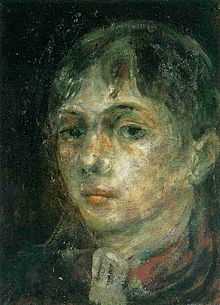Shunsuke Matsumoto




Shunsuke Matsumoto (松本 竣介 Matsumoto Shunsuke, 1912-1948) was a Japanese painter, who primarily painted in the Yōga ("Western painting") style.
Matsumoto was born on April 19, 1912, in Shibuya, Tokyo as Shunsuke Sato.[1] He spent his childhood and youth in northern Honshu, first in Hanamaki, Iwate, and later in Morioka, where he began attending middle school in 1925. The future sculptor Yasutake Funakoshi was among his schoolmates and in the same grade. Matsumoto contracted cerebrospinal meningitis which caused the loss of his hearing. Subsequently he developed an interest in becoming a painter, and left Morioka for Tokyo in 1929.[2]
In Tokyo, Matsumoto took classes at the Taihei Yōgakai Institute (太平洋画会研究所) and became friends with Saburo Aso and Masaaki Terada. In 1935, he exhibited some of his works at the Fifth Nova Exhibition, and his work Buildings was accepted for the 22nd Nika Exhibition. He went on presenting his work at the Nika Exhibitions until 1943.[2]
Matsumoto died at the age of 36 on June 8, 1948, from heart failure aggravated by tuberculosis and bronchial asthma. [1]
Notes
- ↑ 1.0 1.1 Mark H. Sandler : The Living Artist: Matsumoto Shunsuke's Reply to the State. Art Journal, Vol. 55, No. 3, Japan 1868-1945: Art, Architecture, and National Identity (Autumn, 1996), pp. 74–82
- ↑ 2.0 2.1 Matsumoto Shunsuke - website of the Iwate Museum of Art (retrieved 2013-05-01)
References
- Mark H. Sandler : The Living Artist: Matsumoto Shunsuke's Reply to the State. Art Journal, Vol. 55, No. 3, Japan 1868-1945: Art, Architecture, and National Identity (Autumn, 1996), pp. 74–82
| Wikimedia Commons has media related to Matsumoto Shunsuke. |